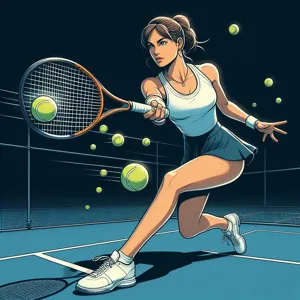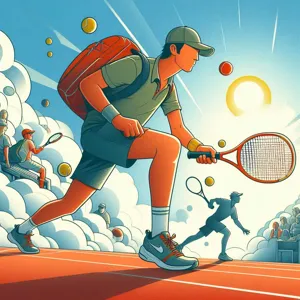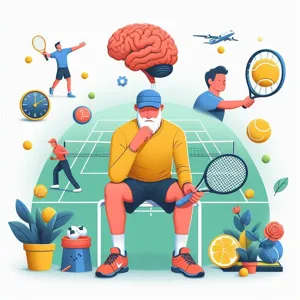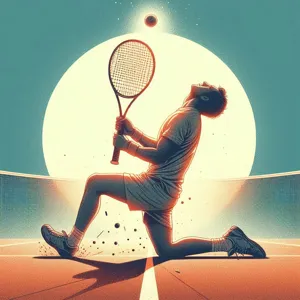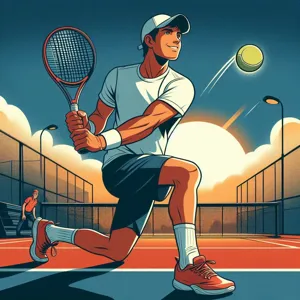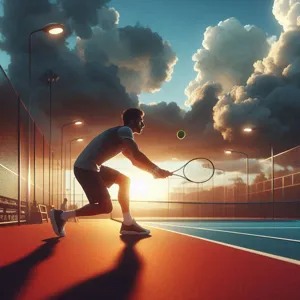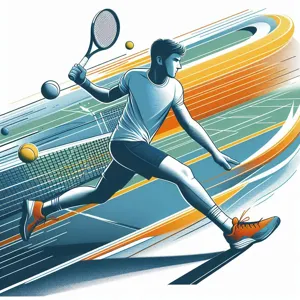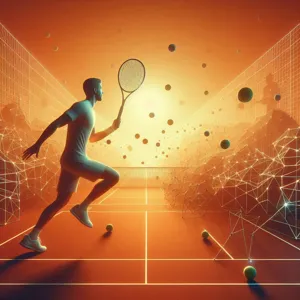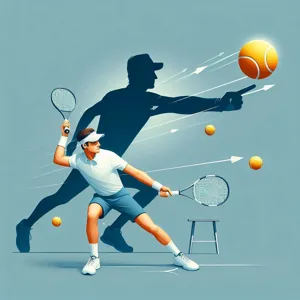Tennis is a sport that combines finesse, strategy, and athleticism, and mastering the topspin can be a game-changer for players of all levels.
This powerful shot not only adds depth and control to your play but also keeps your opponents on their toes, making it an essential weapon in any competitive arsenal. Whether you’re a budding enthusiast looking to improve your baseline game or an experienced player aiming to refine your skills, understanding the mechanics of topspin and incorporating targeted drills into your practice routine can elevate your performance to new heights. In this blog post, we will explore essential drills designed to help you master the topspin, enhance your consistency, and dominate the court. Get ready to unlock the secrets of this crucial stroke and transform your tennis game!
1. Understanding the Topspin: What It Is and Why It Matters

The topspin is a fundamental stroke in tennis that can dramatically alter the trajectory of the ball, making it an essential tool for players at all levels. At its core, topspin occurs when the ball rotates forward as it moves through the air, causing it to dip rapidly after crossing the net. This unique spin not only enhances control over the ball’s bounce but also allows players to hit with greater depth and consistency.
Understanding topspin is crucial because it enables players to dictate the pace and angle of their shots. A well-executed topspin shot can push opponents back, forcing them to play defensively and often resulting in unforced errors. Additionally, topspin provides a safety net; because of its trajectory, you can hit the ball with more power without the constant fear of it sailing long.
Moreover, the topspin stroke is particularly effective on clay courts, where the ball tends to bounce higher, giving players more time to set up for their next shot. Learning to master this technique not only improves your overall game but also enhances your strategic approach on the court. By incorporating topspin into your arsenal, you gain the ability to control rallies and keep your opponents guessing, leading to more winning opportunities. As you delve deeper into the mechanics of this stroke, you’ll uncover how to harness its power and precision, setting the stage for a more dynamic and successful tennis experience.
2. The Physics Behind Topspin: How It Affects the Ball’s Trajectory
Understanding the physics behind topspin is crucial for any tennis player looking to elevate their game. When you strike the ball with topspin, you’re imparting a forward rotation that dramatically affects its trajectory and behavior upon contact with the court. This unique spin causes the ball to dip sharply, allowing it to clear the net with a higher margin of error and drop quickly onto the opponent’s side.
The science behind this is rooted in the principles of angular momentum and aerodynamics. As the ball travels through the air, the topspin creates a difference in air pressure. The top of the ball moves in the same direction as its flight path, while the bottom moves against it, resulting in a downward force that pulls the ball lower, making it less likely to sail out of bounds.
This phenomenon not only enhances your control but also increases your ability to generate depth and pace. The topspin ball can bounce higher off the court, making it more challenging for your opponent to return, especially if they’re positioned too close to the baseline. This strategic use of spin can turn a seemingly simple shot into a tactical weapon, allowing you to dictate the pace of the rally and keep your opponent on the defensive.
To truly harness the power of topspin, it’s essential to practice specific drills that focus on developing your technique and understanding of its mechanics. By mastering the physics of topspin, you’ll gain confidence in your shots, allowing you to play more aggressively while minimizing unforced errors. So, let’s delve into some effective drills that will help you master this critical aspect of your tennis game!
3. Key Elements of a Successful Topspin Stroke

Mastering the topspin stroke is not just about the mechanics; it’s about understanding the key elements that contribute to a successful execution. To elevate your tennis game, you’ll need to focus on three crucial aspects: grip, swing path, and follow-through.
**Grip:** The way you hold your racket significantly influences your topspin. The most common grip for generating topspin is the semi-western grip, which allows for a natural upward motion during your stroke. This grip enables you to brush the ball, creating the necessary lift while maintaining control. As you practice, pay attention to how adjusting your grip can change the angle and spin of your shots. Experiment with different grips to find what feels most comfortable and effective for you.
**Swing Path:** The swing path is where the magic happens. To generate topspin, you’ll want to initiate your stroke below the level of the ball and finish high. Visualize a low-to-high motion, where your racket brushes up against the back of the ball. This upward motion is essential for creating that signature spin. Focus on keeping your elbow relaxed and your wrist firm as you guide your racket through the motion. Incorporating drills that emphasize this swing path will help reinforce the muscle memory needed for a consistent topspin shot.
**Follow-Through:** Never underestimate the power of a good follow-through. After making contact with the ball, your racket should continue its upward motion, ideally finishing above your shoulder. A strong follow-through not only helps to ensure the ball clears the net but also stabilizes your body position for the next shot. Practice this element by swinging through the ball in slow motion, paying attention to how your body naturally aligns with each stroke.
By honing in on these key elements—grip, swing path, and follow-through—you’ll establish a solid foundation for your topspin stroke. Regular practice of these components will not only enhance your topspin technique but also boost your overall confidence on the court, allowing you to play with more aggressive intent and control. Remember, mastering the topspin is a journey, so be patient and enjoy the process of improving your game!
4. Essential Grip Techniques for Executing Topspin
When it comes to mastering topspin, the foundation of your technique lies in the grip you choose. A proper grip not only enhances your control over the ball but also allows you to generate the necessary spin that can dictate the pace and trajectory of your shots. While there are various grips, two of the most essential for executing topspin are the Eastern grip and the Semi-Western grip.
The Eastern grip is often considered a classic choice, particularly for players who prefer a more versatile style. To adopt this grip, imagine holding the racket as if you’re shaking hands with it. Your base knuckle should rest on the third bevel of the racket handle. This grip enables you to hit the ball with a flat trajectory while still allowing for some spin. It’s particularly useful for players who are just beginning to explore the world of topspin, as it provides a solid foundation for different strokes.
On the other hand, the Semi-Western grip has become increasingly popular among modern players due to its effectiveness in generating heavy topspin. To achieve this grip, move your hand slightly more underneath the racket handle, with your base knuckle resting on the fourth bevel. This positioning allows for a more natural upward swing path, making it easier to brush up the back of the ball and create that coveted topspin. With the Semi-Western grip, you’ll notice a significant difference in the spin and depth of your shots, giving you a competitive edge on the court.
To practice these grip techniques, spend some time hitting against a wall or with a partner, focusing on your hand positioning and the resulting spin. Experiment with both grips during your practice sessions, noting how each one affects the way the ball behaves upon contact. Understanding how your grip influences topspin will not only elevate your game but also build your confidence as you learn to control the trajectory and pace of your shots.
Remember, mastering topspin isn’t just about the grip itself—it’s about developing a feel for how different grips translate into effective shots during a match. Incorporating these essential grip techniques into your training routine will set you on the path to becoming a formidable opponent, capable of executing powerful topspin shots with ease and precision.
5. Footwork Fundamentals: Positioning for the Perfect Topspin Shot

Footwork is the unsung hero of a successful topspin shot, serving as the foundation upon which your technique builds. Mastering your footwork not only enhances your ability to generate topspin but also ensures that you’re consistently in the right position to strike the ball with confidence and precision. Here are some essential drills to help you refine your footwork fundamentals and position yourself for the perfect topspin shot.
Begin with the **Shadow Swing Drill**. Stand in an open space, visualize an imaginary ball coming towards you, and practice your footwork without hitting an actual ball. Focus on your stance—ensure your feet are shoulder-width apart, and your knees are slightly bent. As you prepare to hit, practice the split-step, a crucial movement that allows you to react quickly to your opponent’s shot. When you land from the split-step, pivot on your back foot to step forward with your front foot. This movement not only positions you optimally but also helps you load your weight onto your back leg, setting you up to unleash that powerful topspin.
Next, try the **Cone Drill**. Set up cones in various positions on the court to simulate different ball placements. Start at the center of the baseline, and as you move towards each cone, focus on maintaining a low center of gravity and quick, precise footwork. The goal is to approach each cone as if it were a ball coming towards you, ensuring that you’re well-positioned to strike with topspin while maintaining balance and control.
Finally, incorporate the **Crosscourt Reaction Drill** into your practice routine. Partner up and stand on opposite sides of the net. Have your partner randomly hit balls to different areas of the court, forcing you to move quickly and adjust your footwork accordingly. Remember to focus on your foot positioning: always move with small, quick steps to set up for the shot. This drill not only enhances your agility and reaction time but also reinforces the importance of being in the right spot to execute that perfect topspin.
By honing your footwork fundamentals and integrating these drills into your training, you’ll find yourself more agile on the court and better prepared to unleash a formidable topspin shot. With each practice session, you’ll not only elevate your game but also instill a sense of confidence that will serve you well in competitive matches.
6. Drill #1: The Wall Drill for Consistent Topspin
The Wall Drill for Consistent Topspin is an excellent way to refine your technique and build confidence in your strokes. This simple yet effective drill requires only a sturdy wall and your tennis racket. To get started, find a wall where you can hit the ball without obstruction, ensuring there’s enough distance to allow for a full swing.
Begin by positioning yourself about 10-15 feet away from the wall. Stand with your feet shoulder-width apart and assume your ready position, holding the racket with a firm grip. As you toss the ball into the air, focus on generating topspin by brushing up on the back of the ball. Aim for a consistent contact point, ideally at waist height, and visualize the ball arcing over the net as it heads toward the wall.
With each strike, pay attention to your follow-through. Your racket should finish high, above your shoulder to ensure that you’re generating sufficient topspin. After hitting the ball, watch it rebound off the wall and return to you. This immediate feedback allows you to adjust your technique in real-time.
To increase the challenge, vary the speed and intensity of your shots. Start with slow, controlled hits to focus on form, then gradually increase your pace as you become more comfortable. As you progress, try to maintain a rally with the wall, counting how many consecutive hits you can achieve without missing. This not only enhances your consistency but also helps you develop better hand-eye coordination.
Incorporating the Wall Drill into your regular practice routine will make a noticeable difference in your topspin shots, allowing you to dominate the court with confidence and precision. Whether you’re a beginner or an experienced player, this drill is essential for mastering the topspin and taking your game to the next level.
7. Drill #2: The Cross-Court Rally to Enhance Spin Control

Drill #2: The Cross-Court Rally to Enhance Spin Control
The cross-court rally is an essential drill that not only sharpens your topspin technique but also enhances your ability to control the ball with precision and placement. This drill is particularly effective for players looking to develop consistency while adding depth and spin to their shots.
To start, find a partner or, if you’re practicing alone, use a wall or a backboard. Begin at the baseline on opposite sides of the court, ensuring that you’re both positioned to facilitate a back-and-forth exchange. The key to this drill is maintaining a steady rhythm while focusing on the spin of the ball. Aim to hit your forehands and backhands cross-court, targeting the corners of the opposite side of the court.
As you rally, pay close attention to your racket angle and follow-through. To generate topspin, brush up the back of the ball with a low-to-high swing motion. This technique not only adds height and arc but also helps the ball dip sharply as it approaches your opponent, making it more challenging for them to return.
To keep the drill engaging, gradually increase the pace and distance of your shots. You can incorporate specific targets within the court to work on accuracy, or challenge each other to see who can maintain the longest rally without errors. Remember, the focus here is on spin control, so prioritize quality over quantity.
As you progress through this drill, you’ll notice an improvement in your ability to control spin during actual match play. The cross-court rally not only builds your topspin skills but also fosters better court awareness and shot selection, crucial components for any aspiring tennis player. So, grab a partner, hit the court, and let the topspin mastery begin!
8. Drill #3: Partner Drill for Topspin Depth and Accuracy
### 8. Drill #3: Partner Drill for Topspin Depth and Accuracy
When it comes to mastering the topspin, nothing beats the effectiveness of a partner drill designed specifically to enhance both depth and accuracy. This dynamic drill not only sharpens your technical skills but also builds the necessary communication and synergy with your practice partner, essential components of a successful tennis game.
**Setup:**
Begin by positioning yourself on one side of the court, with your partner directly across from you at the baseline. Ensure that both players have a supply of tennis balls ready for action. You’ll be alternating between hitting topspin shots and receiving them, creating a continuous flow of practice.
**Execution:**
Start the drill by taking turns. One player feeds the ball to the other, who will then focus on hitting a topspin shot aimed at a specific target area on the opposite side of the court. This could be a cone, a designated square, or simply a specific section of the baseline. As you strike the ball, emphasize the mechanics of the topspin: low-to-high racket motion, brushing up against the ball, and following through with your swing.
**Variations:**
To enhance the drill, introduce variations. For instance, after a set number of successful shots, switch to hitting cross-court topspin shots, which challenges your ability to control the angle and depth while maintaining that crucial topspin effect. You can also increase the pace by having your partner feed balls more quickly, encouraging you to adapt and react in real-time.
**Feedback:**
Communication is key. After each round, take a moment to provide constructive feedback to each other. Discuss what worked well and where improvements can be made. This reflective practice not only sharpens your skills but also fosters a supportive atmosphere that encourages growth.
**Goal:**
The ultimate aim of this partner drill is twofold: to develop a consistent topspin shot that can clear the net with ample margin while still landing deep within the opponent’s court. By mastering this drill, you’ll not only improve your own game but also prepare yourself to face a variety of opponents with confidence and finesse. As you continue to practice and refine your topspin strokes, you’ll find that the depth and precision of your shots will significantly elevate your overall performance on the court.
9. Incorporating Topspin into Your Serve: Techniques and Drills
Incorporating topspin into your serve can be a game-changer in elevating your tennis performance. A topspin serve not only adds an element of unpredictability but also helps you control the ball’s trajectory, allowing it to dip sharply as it approaches the opponent’s side of the court. Here are some techniques and drills that will help you master this essential skill.
**1. Grip and Stance:** Start by ensuring you have the correct grip. Use a semi-western or eastern grip for your forehand, as this will facilitate the necessary brushing motion to generate topspin. Position yourself in a balanced stance with your feet shoulder-width apart, knees slightly bent, and your body angled towards the net. This foundation is crucial for a powerful serve.
**2. The Toss:** The toss is critical for a successful topspin serve. Aim to toss the ball slightly in front of you and at a height that allows you to make contact at the peak of your reach. A higher toss provides more time to engage the upward brushing motion that creates topspin.
**3. Brush Up the Ball:** As you swing your racket, focus on brushing up the back of the ball rather than hitting it flat. This brushing action will impart the necessary spin. Visualize your racket moving from a low position to a high position, creating a smooth arc that drives upward into the ball.
**4. Target Practice Drills:** To refine your topspin serve, set up targets on the opposite side of the court. Use cones or hula hoops to designate specific areas where you want the ball to land. Start with a few slow, controlled serves to ensure you’re generating topspin, and then gradually increase your speed while maintaining precision.
**5. The “Kick Serve” Drill:** The kick serve is an advanced topspin serve that can throw off your opponent’s rhythm. To practice this, begin with the basic topspin technique and then focus on adding a sideways motion to your body as you hit the ball. This will allow it to kick up higher, making it more challenging to return. Practice this serve with a partner who can provide immediate feedback on the ball’s trajectory.
**6. Video Analysis:** Record your serves to analyze your technique. Look for the angle of your racket during contact and the height of your toss. Reviewing your form can help you identify areas for improvement and reinforce proper mechanics.
Incorporating topspin into your serve takes time and practice, but with these techniques and drills, you’ll soon find yourself not only serving with greater consistency but also adding an unpredictable edge to your game. As you master this skill, you’ll notice an increase in your confidence on the court, and ultimately, more success in your matches.
10. Analyzing Professional Players: Learning from the Best
One of the most effective ways to elevate your tennis game is by analyzing professional players and learning from their techniques and strategies. The best players in the world have honed their skills through years of dedication and practice, making them a goldmine of knowledge for aspiring athletes. Watching their matches isn’t just about enjoying the sport; it’s an opportunity to dissect their styles, footwork, and decision-making processes.
Start by selecting a few players whose playing style resonates with you—whether it’s the aggressive baseline play of a player like Rafael Nadal or the finesse and placement of someone like Roger Federer. Pay close attention to their topspin shots, particularly how they generate spin and control the trajectory of the ball. Notice how they position themselves before hitting, their grip adjustments, and the follow-through that creates that iconic arc over the net.
Utilize resources like match highlights, slow-motion replays, and instructional videos that break down key moments in their games. Many platforms offer detailed analysis of professional matches, highlighting where players excel and where they struggle. Try to replicate their movements during practice sessions, focusing on the mechanics that contribute to successful topspin shots.
Moreover, consider keeping a journal of your observations. Note specific techniques that stand out or strategies that lead to winning points. This reflective practice will deepen your understanding and help you integrate these lessons into your own game. By studying the best, you’ll not only gain insights into advanced topspin techniques but also develop a broader perspective on gameplay, enabling you to make more informed decisions on the court. Remember, learning from the pros is about more than imitation; it’s about adaptation and finding what works best for your unique style.
11. Common Mistakes to Avoid When Practicing Topspin
When it comes to perfecting your topspin, avoiding common pitfalls can be just as crucial as mastering the technique itself. Here are some frequent mistakes players make that can hinder their progress and how to sidestep them for a more effective practice session.
**1. Neglecting the Grip**: One of the most fundamental aspects of generating topspin lies in your grip. Many players mistakenly use a flat grip, which can lead to inconsistent ball trajectory. Ensure you’re utilizing an appropriate grip, such as the semi-western or western grip, which promotes a natural brushing motion that enhances topspin production.
**2. Poor Body Alignment**: Another common error is improper body positioning. Players often fail to align their body correctly with the ball, leading to weak shots. Focus on positioning your feet shoulder-width apart and rotating your hips and shoulders towards the net. This alignment not only improves power but also allows for a more fluid stroke.
**3. Rushing the Swing**: In the quest for power, many players rush through their swings, which compromises control and consistency. Instead, prioritize a smooth, rhythmic motion. Practice slow, deliberate swings to develop muscle memory, gradually increasing speed as you become more comfortable with the technique.
**4. Inconsistent Follow-Through**: A proper follow-through is vital for executing topspin effectively. Players often neglect this part of the stroke, resulting in flat shots or unintentional slices. Focus on extending your arm fully and finishing high above your shoulder. This will not only enhance topspin but also improve your overall shot accuracy.
**5. Ignoring Footwork**: Good footwork is the backbone of a solid topspin stroke. Skipping footwork drills can lead to a lack of balance and timing. Incorporate ladder drills, cone sprints, and shadow swings into your practice routine to enhance your agility and positioning on the court.
By being mindful of these common mistakes and actively working to correct them, you’ll set yourself on the path to mastering topspin. Remember, it’s not just about hitting the ball harder; it’s about hitting it smarter. With focused practice and attention to detail, you’ll elevate your game to new heights, leaving your opponents struggling to keep up.
12. Tips for Developing a Powerful Topspin Forehand
Developing a powerful topspin forehand is a game-changer on the tennis court. It not only adds depth and control to your shots but also makes it challenging for your opponents to return the ball effectively. Here are some essential tips to help you master this crucial stroke.
**1. Grip and Stance:** Start with the right grip; the semi-western grip is often recommended for generating topspin. This grip allows your racket to brush up against the ball, creating that desired spin. Coupled with an athletic stance, make sure your feet are shoulder-width apart and your knees are slightly bent, ready to spring into action.
**2. Backswing:** As you prepare for the shot, initiate your backswing by turning your shoulders and bringing the racket back. Keep your non-dominant hand out in front to maintain balance. A full, controlled backswing sets the stage for a powerful follow-through.
**3. Racket Path:** The key to topspin lies in the racket’s motion. As you swing forward, aim to brush the ball from low to high. This upward motion is essential for imparting topspin. Imagine you are trying to lift the ball over the net while still keeping it within the court boundaries.
**4. Follow Through:** After contact, your racket should continue its upward trajectory. A high follow-through not only reinforces the spin but also helps with the consistency of your shot. Finish with your racket above your shoulder, which will help stabilize your swing and prepare you for the next shot.
**5. Consistent Practice:** To truly master the topspin forehand, incorporate specific drills into your practice sessions. Start with a partner or a ball machine, focusing on the mechanics of your swing. Gradually increase the speed and intensity, aiming to hit targets on the court.
**6. Video Analysis:** Consider recording your practice sessions. Watching yourself play can reveal areas for improvement that you might not notice in real-time. Focus on your grip, stance, and swing path to ensure you’re developing the technique effectively.
By implementing these tips and dedicating time to practice, you’ll not only enhance your topspin forehand but also gain confidence in your overall game. A powerful topspin will allow you to control rallies, push your opponents back, and set up for that winning shot. Get ready to elevate your tennis experience!
13. Tips for Achieving Topspin on Backhands
Achieving topspin on your backhand can significantly enhance your overall tennis game, providing you with greater control, depth, and the ability to keep your opponent on the defensive. To master this crucial shot, there are several key tips and drills to incorporate into your practice routine.
First and foremost, focus on your grip. For topspin backhands, the semi-western grip is a popular choice among many players. This grip allows for a natural upward motion during your stroke, making it easier to generate the desired spin. If you’re transitioning from an eastern grip, take some time to practice with the semi-western grip until it feels comfortable and instinctive.
Next, pay attention to your stance. A stable base is vital for generating power and spin. Position yourself with your feet shoulder-width apart, and slightly bend your knees to maintain balance. As the ball approaches, pivot your body, turning your shoulders sideways to the net. This rotation will help you load your hips and create torque, which is essential for a powerful shot.
When it comes to the actual stroke, remember the “low to high” concept. Start your racket below the level of the ball on the backswing, and as you swing forward, accelerate your racket upwards. The brushing motion against the ball as it meets the strings is what creates the spin. Visualize your racket finishing high above your shoulder; this will not only help in generating topspin but also in ensuring your shot clears the net with enough margin.
To practice topspin backhands, try the following drills:
1. **Wall Drill**: Stand a few feet away from a wall and hit backhands with topspin against the wall. Focus on the low-to-high swing and the grip. This drill allows you to get immediate feedback as the ball rebounds.
2. **Target Practice**: Set up targets on the court—cones or hula hoops work well. As you practice your topspin backhands, aim for these targets, focusing on consistent stroke mechanics and spin.
3. **Partner Drills**: Work with a partner where one of you feeds balls that require topspin backhands. This will simulate match conditions and help you adjust to varying ball speeds and angles.
4. **Shadow Swings**: Without hitting a ball, practice your backhand motion repeatedly. Focus on the mechanics—grip, stance, swing path, and follow-through. Visualization can be a powerful tool in reinforcing muscle memory.
By integrating these tips and drills into your practice, you’ll not only achieve a more effective topspin on your backhands but also gain confidence in executing this essential shot during matches. Consistency and practice are key; before you know it, your topspin backhand will become a formidable weapon on the court, keeping your opponents guessing and on the move.
14. Tracking Your Progress: How to Measure Improvement
Tracking your progress is a crucial component of mastering the topspin and elevating your tennis game. Without a clear understanding of where you started and how far you’ve come, it can be challenging to stay motivated and identify areas that need improvement. Here are some effective methods to measure your progress and ensure you’re on the right path.
**1. Keep a Training Journal:** Start by documenting your practice sessions. Note down the drills you’ve completed, the number of repetitions, and the specific focuses for each session. Over time, you’ll be able to look back and see how your technique and consistency have evolved. This not only helps you track your progress but also reinforces the importance of discipline in your training routine.
**2. Video Analysis:** Recording your practice sessions can be an eye-opening experience. Grab your smartphone or a GoPro and film your topspin shots from different angles. Watching the footage allows you to analyze your form, footwork, and racket angle in real-time. Compare these videos over weeks or months to visually see your improvements and adjust your technique accordingly.
**3. Set SMART Goals:** Implement SMART (Specific, Measurable, Achievable, Relevant, Time-bound) goals for your topspin development. For example, aim to increase the number of successful topspin shots during a practice match from 10 to 15 within a month. Having clear, quantifiable objectives provides direction to your training and a benchmark against which you can measure your success.
**4. Seek Feedback:** Engage with your coach or a more experienced player to get constructive feedback on your topspin shots. They can provide insights you might not notice yourself, helping you to identify strengths and weaknesses in your technique. Regular check-ins will not only motivate you but will also ensure you’re making progress in the right areas.
**5. Match Performance Metrics:** During practice matches, keep track of key performance metrics, such as the number of successful topspin shots, unforced errors, and points won off topspin shots. Over time, you can analyze these statistics to see if your topspin is becoming a more effective weapon in your game, leading to improved match results.
By systematically tracking your progress, you’ll not only gain a sense of accomplishment but also create a roadmap for continued improvement in your topspin technique. Celebrating small victories along the way will keep your motivation high as you strive for mastery on the court.
15. Conclusion: Making Topspin a Key Component of Your Game
In conclusion, mastering the topspin shot is not just about adding a flashy stroke to your arsenal—it’s about fundamentally enhancing your overall game. As you’ve learned throughout this guide, topspin allows for greater control, increased margin for error, and the ability to dictate the pace of play. By integrating the drills outlined in this post into your regular practice routine, you are setting yourself up for success on the court.
Consistency is key; the more you practice your topspin, the more natural it will become in your gameplay. Start by focusing on your grip, footwork, and body rotation—these elements are crucial in generating the ideal spin. Remember, patience is vital. Improvement takes time, so be diligent and persistent in your training.
Moreover, as you incorporate topspin into your matches, pay close attention to how it influences your opponent’s responses. You’ll notice that a well-executed topspin can push your adversary out of position, opening up the court for strategic shots and opportunities. Use this to your advantage, and soon you’ll find that your confidence in deploying topspin will elevate all aspects of your tennis strategy.
As you continue to develop your skills, embrace the topspin as a key component of your game. With dedication and practice, it will not only enhance your performance but also bring a new level of enjoyment to your tennis experience. So grab your racquet, hit the court, and let the topspin fly!
As we wrap up our exploration of mastering the topspin, we hope you feel inspired and equipped with the essential drills to elevate your tennis game. Developing a powerful topspin can transform your play, allowing you to dictate the pace of the match and gain a competitive edge over your opponents. Remember, practice is key—dedicate time to refine your technique, embrace the learning process, and don’t shy away from challenging yourself. Whether you’re a seasoned player or just starting out, incorporating these drills into your routine can lead to remarkable improvements in your performance on the court. Now, grab your racket, hit the practice courts, and watch your game take flight with every spin!


